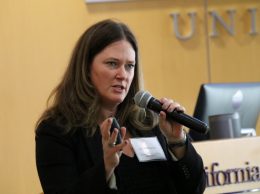Opinion: We must prepare for rising seas
By Loredana Carson
Sea level rise is an issue that looms large on the horizon, but the horizon appears to be way off in the distant future. Many experts give predictions of tidal waters rising 6 to 10 feet along the coast by 2100. Others choose to focus on 2050 and believe 3 feet is the area of impact around which we need to plan.
Although we do not know the exact trajectory of the sea, we know the water will rise. The probability modeling is in constant flux, which adds to the confusion, as what was said in 2019 is already outdated in 2021. The extreme projections of the 10-foot water rise seem improbable, but that does not suggest we should ignore the possibility.
No one knows exactly what will happen in 100 years’ time. The only thing most scientists agree on is that the cost of not preparing is too expensive to contemplate. The California Legislative Analyst’s Office states that every dollar we spend today can save $6 in the future.
How society chooses to prepare for and mitigate the issues surrounding climate change, polar ice melt and the resulting sea level rise will impact future generations in many ways. The tri-county area is not exempt from risk, and, in fact, all three counties are engaged in vigorous planning and debate on the best path forward.
“Uncoordinated actions can negatively affect the trajectory of communities along the Ventura County coastline, alter the fiscal sustainability of the state of California, complicate the U.S. defense strategy and disturb the rhythm of the global economy,” wrote three California Lutheran University students helping county staff assess the issue this summer.
Addressing sea level rise is incredibly complex because it involves so many dimensions. It starts with science, but the analysis must consider both social and economic implications of the various adaptation strategies, which range from moving structures to making alterations that reduce risk to redistributing sand around the coastline.
There will be environmental implications that require us to examine the specific risks in areas near toxic industrial sites. We must address how we can prevent displacement of both homes and jobs as well as how we can protect coastal habitats and preserve access to the beachfront itself.
There are many moral and ethical questions to consider. The options for preparing for sea level rise involve a menu of choices, each of which has pros and cons.
To become better informed you can attend meetings and continue to read about and study the issue. Here are some resources for learning more about sea level rise, climate change and the impact on coastal communities:
• The section of NASA’s Global Climate Change website devoted to mitigation and adaptation;
• The county of Ventura’s website on sea level rise.
To support good decision-making you can participate in focus groups, complete surveys, speak up when incorrect information is shared and work with legislators and other policymakers.
In addition, there is a need for more professionals with the skill sets needed to design, build, operate and maintain climate-safe infrastructure. Most importantly, we need to teach students of all ages, from elementary school to college, to appreciate systems thinking, which links concepts from multiple areas to develop solutions to complex problems. This requires funding our primary, secondary and higher education institutions and incentivizing programs that teach design approaches and techniques and stress methods of stakeholder engagement, communication and cultural competency to allow diverse groups to work together efficiently and effectively.
• Loredana Carson is a lecturer in the Master of Public Policy and Administration program in the California Lutheran University School of Management.











